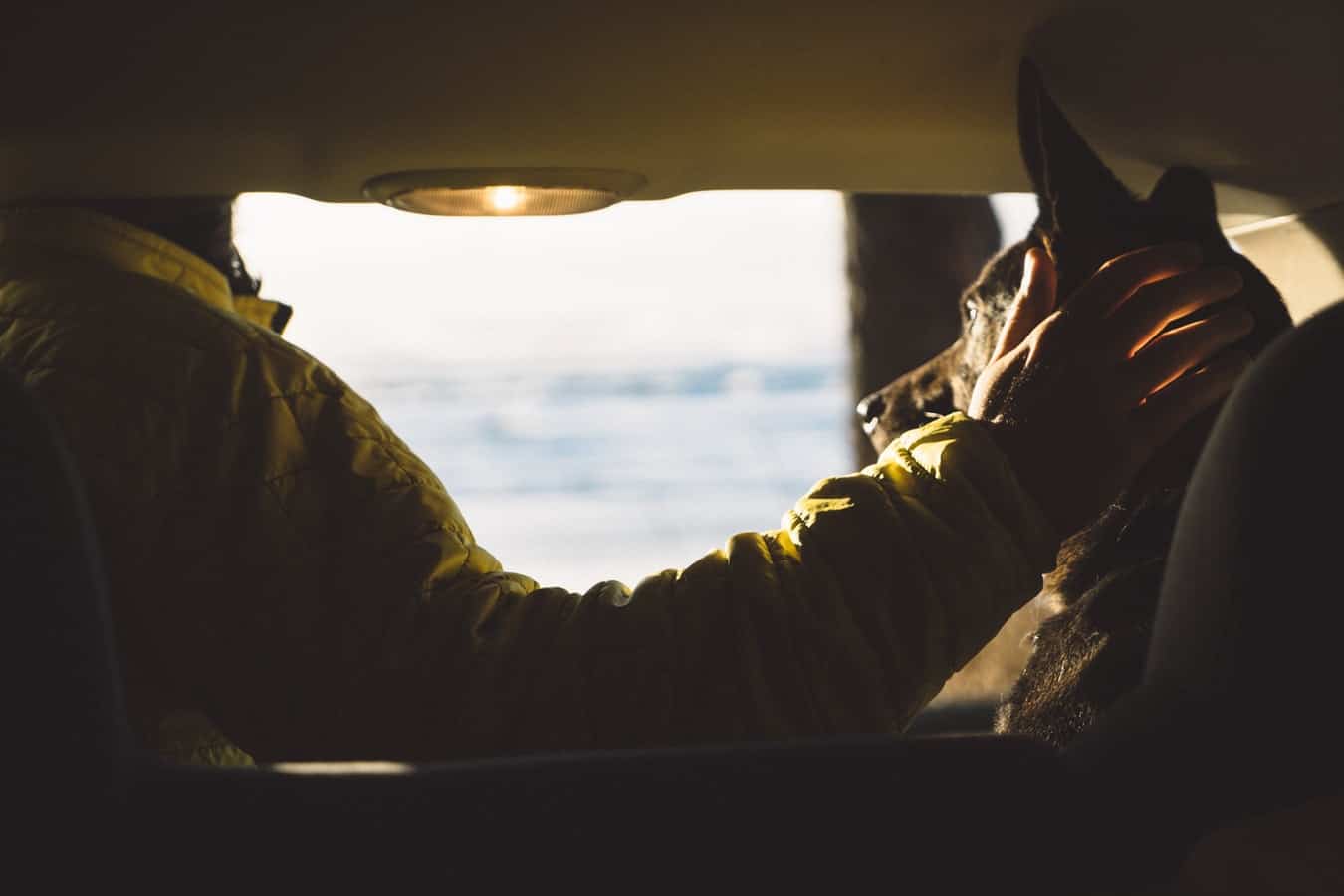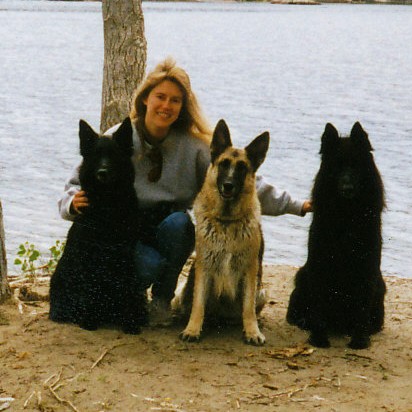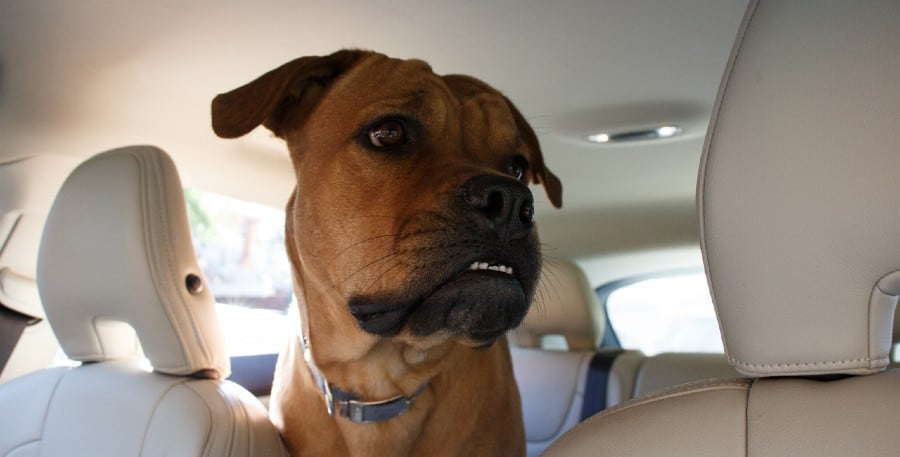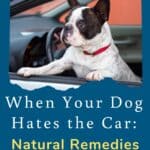What’s a road trip without the dog along? Sadly, many dogs do not handle travel as well as they could. Get tips, training advice, and natural remedies to help banish your dog’s travel anxiety for good.
If you’ve had a dog with car sickness or travel anxiety, you know it’s not something you’d wish on your worst enemy. Your dog may whine, bark, shake, drooling, vomit, or even worse. It’s frustrating – and disheartening – to see your dog so miserable. And the mess – oy!
In this article, we’ll go through why dogs can become carsick and anxious, offer some tips on how to improve their experience and discuss Bach flower essences and other natural remedies that can help solve the problem once and for all.
Why Do Car Rides Make Some Dogs Sick and Anxious?
Vestibular issues. An inner ear that’s not finished developing can lead to dizzy sensations and lack of balance. Typically, this resolves as the dog matures. In fact, most dogs grow out of car sickness somewhere between 6 and 12 months of age, with bigger breeds taking longer to finish developing.
Bad associations. Dogs are masters of association. If If something happens while you’re riding with your dog that is scary or unsettling enough, even an adult dog who was previously fine in the car can become afraid of car rides. What kind of scary events? It could be any number of things. A big thunder clap while riding in the car, an accident or close call… many things can happen to create a negative association with cars in your dog’s mind.
No experience with the sensation of movement under them. Good breeders will get young puppies used to a variety of sensations, including those of a moving car. Those who do not take young pups on car rides (even brief ones) are doing their buyers no favors. Lack of experience in early puppyhood can be as bad as a very negative, frightening experience later on.
Fear imprint. Puppies go through what’s called a “fear imprint†period when approximately 8 to 11 weeks old. Having an especially stressful or frightening experience during this period can affect a dog long term. A particularly negative car ride (or plane flight) during this time frame could predispose a dog to car sickness and travel anxiety.
Practical Tips for Calmer Car Rides
Before getting to what you can give your dog, let’s go through some practical tips to help improve your dog’s experience with car rides. Travel anxiety can be such a tough problem to live with that it pays to approach it from several angles, if possible.
Things you can do right now:
Make sure your dog is secure in your car. Using a car crate, harness, dog-seat, or vehicle barrier will help prevent your dog from rushing from window to window, and help keep him from working himself into a frenzy. If using a crate, be sure to provide non-slip footing. There’s nothing more stressful than slipping and sliding at every curve!
Secure any items in the car that shift, bump, rattle, or bang on the road. If your dog is already a little tense on car rides, that extra bit of weird, startling, or out of place noise may be just enough to put him over the edge.
The gentle physical pressure of a well-fitted car harness, snug t-shirt, Thundershirt, or anxiety wrap may help some dogs to relax while riding. (Get your dog used to these items first, in a comfortable, familiar environment away from car rides. And always be sure you’re able to visually supervise your dog while wearing any of these.)
It’s usually recommended that dogs prone to car sickness travel on an empty stomach. How empty – whether a few hours without food or overnight – is something you’ll need to determine for your dog. It’s fine (and good) to make sure your dog has access to water, though.
Most dogs prefer plenty of air flow and fresh air while traveling. So, open a window or two and learn to appreciate that wind-blown look!
Experiment with having your dog ride in a different part of your car. Some dogs do better nearer the front, or on the floor, or up higher where they can see out.
Alternately, experiment with covering your dog’s crate so he can see less or not at all, or only in certain directions. Car sickness is not a one-size-fits-all problem, so try different things and see what your dog responds to.
Try letting your dog acclimate to the car before taking off on a drive. Put your dog in the car early (say, 10-20 minutes) and leave her in it for a similar amount of time after you arrive at your destination. This allows your dog to settle and acclimate both before and after the ride. (This assumes your dog is not destructive when left alone in the car. If she is, make sure your dog is crated when left alone.)
What about dogs that stay upset and nauseous after the ride is over? I had a puppy awhile back who would not only feel sick in the car but would stay nauseous and miserable after we arrived at our destination. This made for some tough puppy classes! I eventually found that if I gave her a chance to hang out in the car after we arrived, then engaged her in a game of her very most favorite thing in the whole world (frisbee), she would snap out of her “I will never see the light of day again†attitude. Frisbee after a period of settling worked for my dog. Experiment and find something that snaps your dog out of its disorientation.

Things you can work on:
Many people avoid car travel with their anxious dogs, since having a stressed out, drooling or agitated dog in the car is not fun for anyone. While there is no crash course (pardon the pun) for acclimating your dog to car travel, her attitude can be greatly improved with a slow, steady approach.
Try to pinpoint what your dog finds anxiety-provoking about car travel. Does he hop in the car just fine? Ride to the corner and back no problem? Okay if alone but not with another dog (or vice versa)? Hate riding in rainy weather? Only anxious on bumpy or curvy roads? Isolating what your dog has trouble with will allow you to make a more effective treatment and training plan.
Take your dog with you on very frequent, very short trips to relaxing, pleasant places. What’s “very frequent”? Daily, if possible. What’s “very short”? Start with around the block, or down and back to the corner store. Do something pleasant when you return home. Work up to visits to a nearby park, field, or friend’s house. Even a parking lot greenspace will work as a low-key, pleasant destination. Gradually increase the distance you drive, but continue to intersperse the longer drives with very short outings.
Create better associations. Find out what your dog enjoys and take car rides to places where you can do those activities with your dog. While a walk in the park can work great for most dogs, play around with other activities to see what changes your dog’s attitude about car rides.
Several years ago, one of my Belgian Sheepdogs seemed, for all the world, that she would have lifelong car anxiety. Then we started tracking training. After 2 or 3 lessons, instead of pacing and panting the entire trip, she sat and gazed calmly (and intently) out her window on the way to the tracking field. Within a few short weeks, she was utterly calm in the car! This was in a 5 year old dog, and the only change we made. Finding something that your dog can truly look forward to can make all the difference in creating better associations with car rides.
Train in your car! This is one of those things that simply never occurs to many people. We train in the house, the yard, anywhere we expect our dogs to behave, but rarely in the car. Training sessions will help your dog understand that there are expectations in the car, and will improve his sense of security while traveling.
What kind of training? Sit, lie down, stay, and wait on a blanket are all great places to start. You can include tricks and play to build confidence. Begin in your parked car, then enlist the help of a friend so that you can train while the car is moving.
Why does this help? A dog that feels helpless in an uncontrolled situation will tend to feel more secure with some structure, which includes knowing your expectations. Teaching your dog to focus on other things than the car, and to calm and control himself through obedience can actually reduce his overall anxiety in the car.
And the dog that dashes from window to window, totally overwhelmed and hyper-stimulated by movement? Whether or not this is pure excitement (it may be a mask for anxiety), this dog will benefit from understanding that it’s possible and expected to have some self-control and manners while riding.
Avoid fretting. Having a dog that gets sick or super-stressed in the car is a miserable experience. It’s hard not to check on them every 30 seconds to see if they’re okay. My own feeling is this is the worst thing you can do. The dog senses your anxiety and piles it on top of her own. So, while I’m not saying you can cure dog car sickness by pretending it doesn’t happen, I do think it’s fair to say you can avoid making it worse by not projecting your stress (and annoyance, and frustration) onto your dog.
Change the context (big time). Okay, and I realize this isn’t exactly a “practical†tip for most people. But, if you’re in the market for a new ride, I’ve known several dogs whose long-term, consistent car sickness disappeared when the owner bought a different vehicle. So, if you’re planning an auto purchase anyway, your dog’s car anxiety might just improve (or go away completely) with a new car.
Flower Remedies for Car Sickness and Travel Anxiety in Dogs

Now what most people are looking for: what they can give their dog for travel anxiety. I’m going to start with flower essences, particularly Bach flower essences such as Rescue Remedy. I want to include these as a section of their own for a few important reasons:
- For many dogs, flower essences can quickly, safely relieve travel anxiety with zero side effects.
- Flower essences can be selected to help alleviate the reasons behind your dog’s distress and upset in the car, instead of simply masking the problem. This is because flower essences actually work to balance out-of-balance emotions, and act to “re-tune your dog’s reactions.
- Flower essences can be safely used in combination with other natural remedies and medications. There are no contraindications. Pretty cool!
Let’s look at which Bach flowers can potentially help your dog be a happier camper in the car.
Rescue Remedy for travel anxiety in dogs
Rescue Remedy is the original “emergency” formula of Dr. Edward Bach, the discoverer of Bach flower essences. It’s a combination of five essences, and is the most popular Bach flower blend (and arguably the most popular alternative supplement, period) for car travel anxiety in dogs. Rescue Remedy reduces panic and stress and restores calmness. If your dog is stressed out, fearful and panicky in the car, try Rescue Remedy first.
More flower essences for travel anxiety in dogs
Scleranthus is the Bach flower for unsteady, up and down mood swings and emotions. Scleranthus can help with motion sickness by improving balance issues.
Aspen is the Bach flower for vague apprehension and anxiety. If your dog is generally anxious and nervous in the car, Aspen relieves anxiety and improves calmness and courage.
Mimulus is the Bach flower for specific fears, phobias, and timidity. It improves courage and confidence. If your dog has a specific fear about car travel, Mimulus can help reduce that fear and improve your dog’s confidence and ability to cope.
Rock Rose is the Bach flower for panic. Dogs that get truly panicked and terrified on car rides, that freak out or try to escape, or that, on the other hand, freeze up in fright, will benefit from Rock Rose. Rock Rose reduces panic and improves steadfastness and courage.
Impatiens is an important Bach flower for car travel. It’s the flower essence for – you guessed it – impatience, but also for frustration and nervous-hyper behaviors. For the dog that shakes, paces, dashes from window to window, or is very physically tense on car rides, Impatiens is a good addition to your dog’s travel blend.
Cherry Plum is another helpful Bach flower for car rides. This one is for the dog that really loses control, or barely maintains control. If your dog freaks out or panics about confinement, Cherry Plum will be an important addition in helping your dog stay in control.
Chestnut Bud is a Bach flower essence that’s useful if your dog has a longstanding habit of anxiety in the car. Chestnut Bud can loosen up old patterns of behavior and open your dog up to new, improved patterns. If your dog’s car sickness and/or car anxiety seem to be very resistant to improvement, try Chestnut Bud in the mixture.
Finally, Chamomile (which is actually a North American versus Bach flower essence) soothes and helps release emotional tension that is held in the stomach. As you can imagine, this can be very helpful for dogs that get a sick stomach from their heightened emotions while riding in the car. Chamomile gently calms frenetic emotions, thoughts, and activity, so is perfect for the dog that has difficulty relaxing when traveling.
And while those aren’t all the possible flower essences that can be used for travel anxiety in dogs, they’re a good start.
Aldaron Essences’ flower essence blends for car travel anxiety
Aldaron Essences’ online store closed permanently on May 31, 2023. I no longer sell flower essence formulas directly to customers.
Instead, I’m focusing on developing the Aldaron Essences blog into a premier resource on flower essences for dogs and other animals. I’ll also be expanding my dog training website, Train2Behave.com, as well as my Etsy store of mostly dog training- and breed-related apparel and gifts.
In the coming weeks, you can expect new pages on this site that will detail some of my most popular flower essence formulas for dogs. These pages will replace the old links to those products on the store. Thanks for your patience during the transition!
Best,
julie
Aldaron Essences has several pre-designed flower essence blends to help with travel anxiety in dogs. Our travel formulas start with Rescue Remedy for severe stress, then add other helpful essences to address common emotional states in dogs that have trouble with car trips.
Easy Rider is a blend of Rescue Remedy, with additional Bach flower essences for anxiety, panic, tension and shakiness, disorientation, and overwhelm. This is probably our most popular travel remedy for dogs.
Travel Calm is a blend of Rescue Remedy and essences for fear and wild-running thoughts, disorientation, and nervous tension that tends to concentrate in the stomach. It’s great for the dog that gets agitated, restless, and generally nervous on rides.
Poise is not a travel formula per se, but is frequently used as one. It’s a combination of Rescue Remedy for stress, with additional Bach flowers to relieve anxiety, fear, panic in the dog that “freaks out” on car trips.
How to use flower essences for travel anxiety

Flower essence formulas should be used on a daily basis if car rides are a regular occurrence. If car travel is not something your dog does very often, they can be given closer to the trip. For occasional trips, I generally recommend giving the formula 3 times each day, starting 2 days in advance of the trip or car ride. You can safely increase the frequency the day of the actual ride.
Flower essences are most commonly taken internally. Dogs of all sizes may be given 3 or 4 drops directly in the mouth, or added to food, treats, water, etc. They can be applied topically or misted around the dog. To learn about the variety of ways to give flower essences to animals, see my blog post, Simple, Effective Ways to Give Flower Essences to Animals.
Other Natural Car Sickness Remedies for Dogs
As I mentioned, flower remedies are completely safe to combine with other remedies and therapies for travel anxiety. So, if you want to cover your bases, or if your dog’s car anxiety is particularly stubborn, here are some additional remedies to try.
Be sure to check with your dog’s veterinarian first before giving unfamiliar medications or supplements to your dog, particularly if they are pregnant, nursing, have a medical condition or history of seizures or any serious illness.
A real ginger snap cookie (or piece of one, if your dog is small) has been a near-instant car sickness cure for many of my dog training clients. Watch out for ingredients that are not dog-friendly, like xylitol or chocolate, both of which are toxic to dogs. Also be aware if your dog has any food sensitivities to avoid. Finally, make sure the cookie you choose uses real ginger!
An interesting remedy that was new to me is giving your dog a small sugary candy just before the car ride. Small means small – say, the size of a jelly bean. And be absolutely sure it contains real sugar and not a toxic substitute like xylitol.
DAP (Dog Appeasing Pheromone) can have a calming effect on nervous dogs. DAP, a behavior-influencing pheromone, is not taken internally but is breathed in by the dog. To use for travel anxiety, spray DAP inside the car shortly before taking your dog for a ride.
Homeopathic Nux vomica can be a quick, effective natural remedy for queasiness. Keep this on hand to use if your dog starts to feel sick while riding.
Lavender or chamomile essential oil dabbed onto a cloth or cotton ball and placed in the car – away from the dog – 15 minutes or so before the drive may help relieve travel anxiety in some dogs.
Peppermint extract dabbed onto paw pads acts as an anti-anxiety in some dogs. Apply it just before or at the beginning of the ride. Keep in mind this is extract (such as you’ll find in the grocery store for used in cooking), not essential oil. In general, essential oils should not be applied directly onto a dog’s skin.
And what about the commonly recommended Dramamine and Benadryl? These are OTC medications not approved for dogs but commonly used by dog owners for motion sickness and travel anxiety. Both Dramamine and Benadryl can be very effective to reduce drooling and vomiting.
However, it’s important for dog owners to be aware that these medications may interact poorly or unpredictably with other medications, and are not appropriate for dogs with certain medical conditions or histories.
- Common side effects of Benadryl include dry mouth, increased heart rate, rapid breathing, hyper-salivation and urinary retention. Side effects for Dramamine may include drowsiness, fatigue, dry mouth, and urinary retention. Less commonly your dog may experience diarrhea, vomiting and poor appetite as a side effect.
- If you’re planning to use Benadryl or Dramamine for your dog’s car sickness, consult your dog’s veterinarian first to be 100% sure of appropriate dosage and if this medication is safe for your dog.
Conclusion
Travel anxiety and car sickness in dogs is a common but challenging problem. Fortunately, many dogs will outgrow the issue given time and some positive experiences.
There are quite a few practical steps you can take to improve your dog’s attitude toward car rides. Natural remedies and supplements are a valuable tool, especially when used as part of a holistic approach.
Flower remedies really shine in this regard and should be considered at the top of your list for relieving travel anxiety in dogs.
I hope you enjoyed this article and found it useful. If you did, I’d appreciate it if you could tell your friends!

Julie Cantrell BSc is a professional dog trainer and canine behavior consultant who’s logged many thousands of hours training dogs and teaching owners since 1990. Flower essences have been part of her work with canine behavior since 1994. (Bio)









